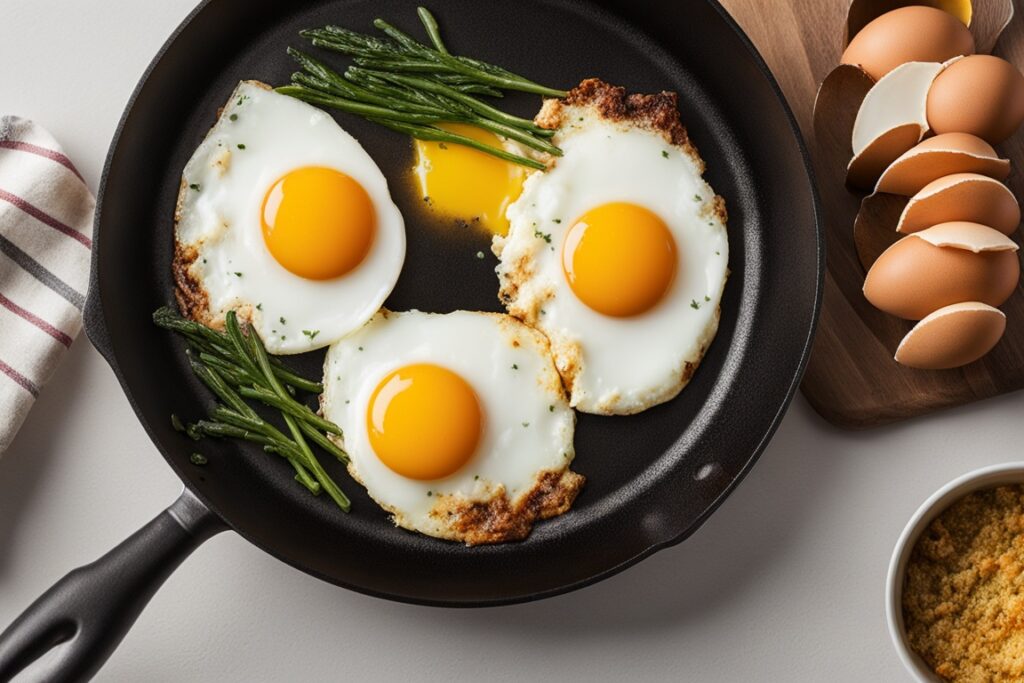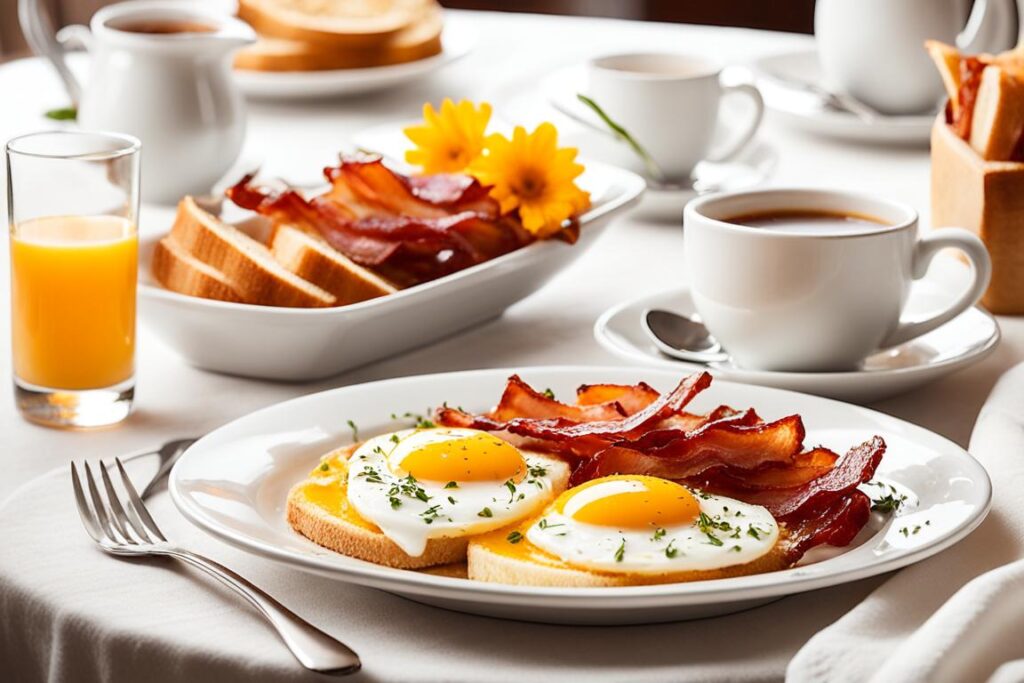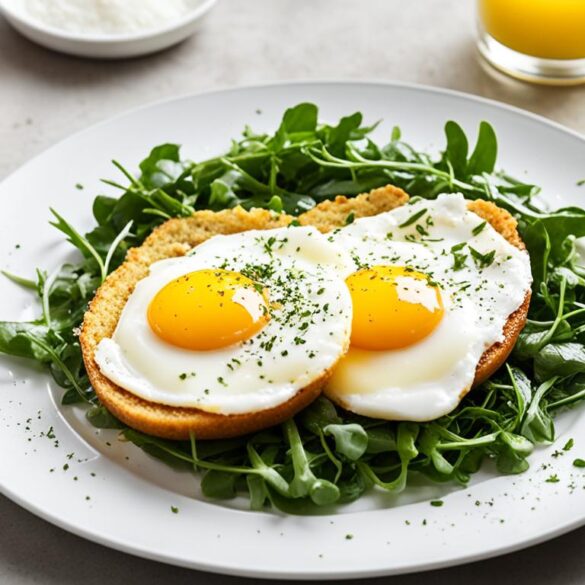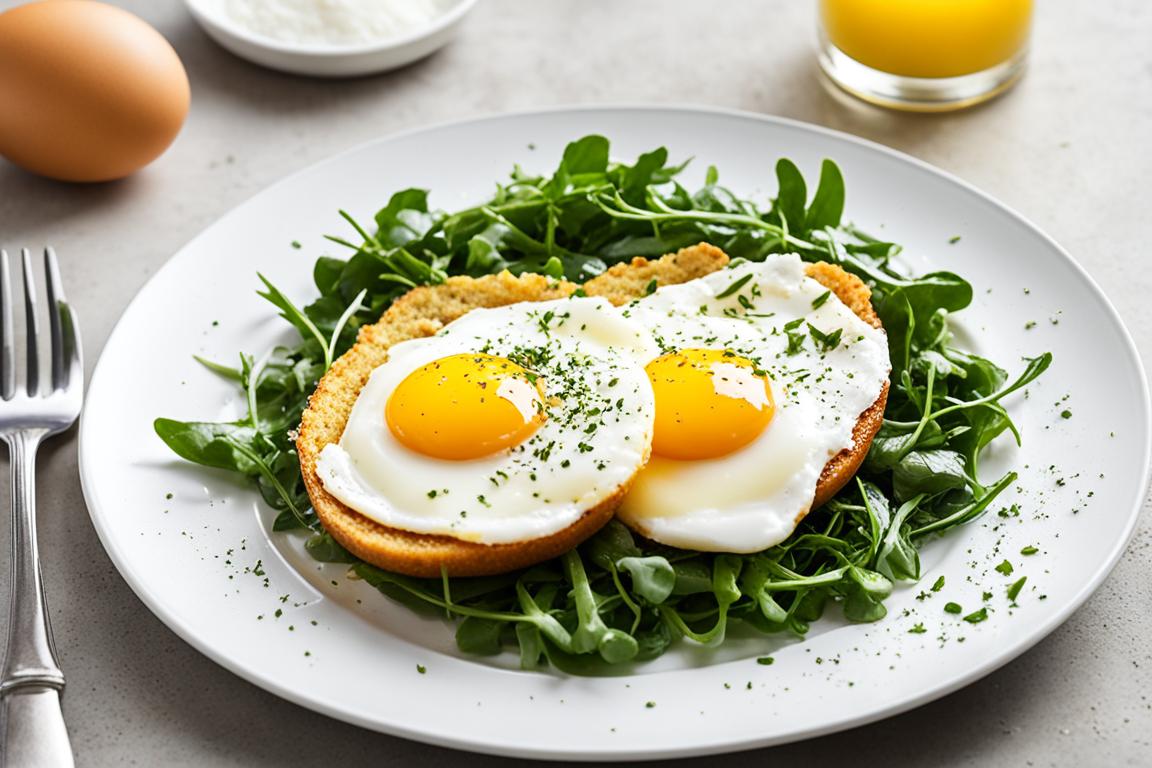Welcome to your ultimate guide to over hard eggs! This method is a key part of American breakfast. When done right, over hard eggs give you firm whites and runny yolks. They’re perfect for those who love texture and flavor in their breakfast.
Learning how to make perfect egg preparation might seem hard, but we’re here to help. With our guide, you’ll be making delicious over hard eggs in no time. Let’s explore the art of making your breakfast better.
Key Takeaways
- Over hard eggs are fully cooked eggs with firm yolks.
- Precision and technique are crucial for perfect egg preparation.
- Understanding the right ingredients and tools ensures success.
- Over hard eggs hold a special place in American breakfast culture.
- This guide covers everything from ingredients to serving suggestions.
What Are Over Hard Eggs?
Over hard eggs are a favorite breakfast choice for many. They are fully cooked yolks. This method cooks the eggs until both the whites and yolks are set. They are great for many dishes.
Definition of Over Hard Eggs
Over hard eggs are fried eggs cooked on both sides until the yolk is fully set. This makes them different from other methods where the yolk might be runny. People like them for their solid texture, especially in sandwiches or big breakfasts.
Differences from Other Egg Cooking Methods
Over hard eggs stand out from other egg cooking methods like sunny side up, over easy, and scrambled. Sunny side up eggs are cooked on one side, leaving the yolk runny. Over easy eggs are flipped but still have a bit of runny yolk. Scrambled eggs mix everything together until it’s fully cooked. Over hard eggs are flipped and cooked until the yolk is solid, giving a consistent texture.
- Sunny Side Up: Yolks are runny and visible on top.
- Over Easy: Yolks are flipped but remain slightly runny.
- Scrambled: Entire egg mixture is stirred until fully cooked.
- Over Hard: Both whites and yolks are fully cooked through.
Knowing these differences helps pick the right egg doneness for your dishes. Over hard eggs are a solid choice for those who like a firmer yolk.
Essential Ingredients for Perfect Over Hard Eggs
To make the best over hard eggs, picking the right ingredients is key. Using top-notch items makes your breakfast tasty and full of flavor.
Choosing the Best Eggs
For over hard eggs, choose the best eggs you can find. Go for organic, free-range, or farm-fresh ones. These eggs are more nutritious and taste better, making your eggs more flavorful. Make sure to check the packing date and use them within a few weeks for the best taste.
Recommended Oils and Fats
The oil or fat you use matters a lot. High-quality options like butter, olive oil, or bacon grease are great choices. Each fat has a smoke point that affects how well it works at high heat:
- Butter: Adds richness but has a lower smoke point. Ideal for lower heat frying.
- Olive Oil: Versatile with a moderate smoke point, offering a subtly fruity flavor.
- Bacon Grease: High smoke point fat that infuses a smoky, savory taste.
Seasonings to Enhance Flavor
Seasonings can really boost the taste of your over hard eggs. Simple but quality items like sea salt, black pepper, and smoked paprika work wonders. For more flavor, add garlic powder or fresh herbs like chives or parsley.
Choosing the Right Pan for Cooking
Choosing the right pan is key to making perfect hard-boiled eggs. You can use a frying pan, non-stick cookware, or a cast iron skillet. Each has its own benefits for cooking your favorite egg dishes.
Non-Stick Versus Cast Iron Pans
Non-stick cookware is great because it makes food easy to release and clean up is simple. It’s perfect for quick breakfasts. But, remember it can’t handle high heat and needs gentle tools to avoid damage.
A cast iron skillet keeps heat well and lasts a long time. It needs regular care but can be passed down for generations. It’s great for cooking hard-boiled eggs with crispy edges.
Proper Pan Maintenance
Pan care is crucial for your cookware’s life and performance. For non-stick pans, use soft sponges and wooden or silicone tools. Avoid metal utensils and harsh cleaners. Dry it well after washing to prevent rust.
Looking after a cast iron skillet means regular seasoning. Clean it with warm water and a brush, no soap if you can help it. Dry it fully, then oil it to stop rust. Good pan care keeps your skillet in great shape for consistent cooking results.
Step-by-Step Guide to Cooking Over Hard Eggs
Learning to cook perfect over hard eggs is easy with the right steps. This guide will show you how to get crispy egg edges and a perfectly cooked yolk every time.
Prepping Your Ingredients
First, collect your ingredients. Use fresh, high-quality eggs for the best taste. Choose pasture-raised or organic eggs if you can. You’ll also need oil or fat for cooking, like butter, olive oil, or avocado oil.
Heating the Pan to the Correct Temperature
Preheat your pan over medium heat for a minute before cooking. It’s important to get the pan hot enough. If it’s too hot, you might burn the eggs. If it’s too cool, you won’t get crispy edges.

Cracking and Adding Eggs to the Pan
After heating the pan, add a tablespoon of oil. Swirl it to cover the pan for non-stickiness. Carefully crack each egg into the pan without breaking the yolk. Season with salt and pepper.
Flipping and Cooking to Doneness
Watch as the eggs cook until the whites set firmly. This should take about 2-3 minutes. Use a spatula to gently flip each egg over. Cook for another 1-2 minutes, depending on how you like your yolk.
Follow this cooking guide to make perfect over hard eggs easily. With practice, getting crispy edges will become easy.
Tips for Achieving Crispy Edges
Creating over hard eggs with crispy edges takes some skill and attention. Paying attention to heat and oil distribution in the pan is key. This will help you get those golden, crunchy edges that make your eggs stand out. Here are some tips to help you achieve perfect results.
Managing Heat Levels
Getting crispy egg edges means managing your heat well. Start with a pan that’s hot enough. If it’s too low, your eggs will cook too slowly and might turn rubbery. If it’s too high, the edges could burn while the yolk stays raw.
Try to keep the heat at medium-high. Let the oil shimmer before adding the eggs. This ensures they cook evenly and get that perfect crust.
The Importance of Oil Distribution
Even oil distribution is crucial for crispy egg edges. Use enough oil, like vegetable or canola oil, and spread it evenly in the pan. This helps create a consistent crust on the eggs.
For more tips on frying eggs perfectly, check out this guide on frying eggs to perfection.
Remember, getting it right takes practice. With these tips, your over hard eggs will be delicious and have those crispy edges everyone loves.
Serving Suggestions for Over Hard Eggs
Learning how to serve over hard eggs is just as crucial as cooking them. We’ll look at creative ways to pair them with breakfast foods. We’ll also show how to add them to your diner menu or brunch.
Pairing with Breakfast Foods
Over hard eggs shine as the main attraction in any breakfast. They’re perfect for weekend family meals or updating your diner menu. Here are some classic pairings:
- Over hard eggs with crispy bacon, toasted sourdough, and fresh fruit
- Eggs Benedict with over hard eggs for a richer taste
- Breakfast tacos with over hard eggs, cheese, avocado, and salsa
- Hash browns topped with over hard eggs and chives
Incorporating into Brunch Menus
Put over hard eggs at the center of your brunch. Here are some new ways to feature them on your menu:

Over hard eggs bring versatility and flavor to any brunch. They can be part of creative dishes or traditional favorites:
- Egg and avocado toast with over hard eggs, cherry tomatoes, and microgreens
- Frittatas with sautéed veggies, cheese, and over hard eggs
- Classic brunch burgers topped with an over hard egg
- Grain bowls with quinoa, roasted veggies, over hard eggs, and vinaigrette
Common Mistakes to Avoid
Cooking over hard eggs is a skill worth learning, but some mistakes can ruin your dish. Let’s look at how to avoid these errors for perfect egg doneness.
Using the Wrong Pan
Choosing the right pan is key to frying eggs well. The wrong pan can cause uneven cooking and sticking. Non-stick pans are great for preventing sticking, but cast iron pans can also work well if kept in good condition.
Incorrect Temperature Control
Managing the heat is crucial when cooking hard-boiled eggs. If the heat is too high, the edges might burn before the inside is fully cooked. If it’s too low, the eggs could turn rubbery. Finding the right temperature ensures your eggs are perfectly cooked.
Overcooking the Eggs
Overcooking is a mistake that can make your eggs tough and flavorless. To prevent this, remove them from the heat when the yolks start to set. This way, your eggs will be tender and fully cooked.
Why Over Hard Eggs are a Breakfast Favorite
Over hard eggs are a top pick for breakfast food. They’re loved for their great taste, texture, and ease of preparation. These qualities make them a key item on any diner menu.
People love over hard eggs in both American diners and home kitchens. They’re great with many breakfast foods and are packed with egg nutrition. They have a lot of protein and important vitamins like B12 and D, making them a healthy start to the day.
Over hard eggs are also very versatile. They fit well with low-carb, keto, or traditional American diets. This makes them a favorite among different people and diets.
They’re always on diner menus, showing how much people like them. Customers enjoy the reliable quality and familiar taste of this classic dish. It’s a go-to choice for any meal.
The mix of great taste, nutrition, and flexibility keeps over hard eggs a beloved breakfast choice.
Conclusion
Learning to make perfect over hard eggs is a fun journey that makes any breakfast or brunch special. This guide has shown you how to pick the best ingredients and tools. It also taught you the key steps to get a delicious result every time.
Starting with fresh, quality eggs is crucial. You also need the right oils and seasonings. Having a good non-stick or cast iron pan is also important. As you get better, focus on controlling the heat and oil for crispy edges.
We talked about how to serve your eggs, from classic breakfast to vibrant brunch dishes. Avoid mistakes like using the wrong pan or overcooking. This guide values patience and practice, encouraging you to enjoy the process. Making perfect over hard eggs is rewarding and worth the effort.
FAQ
What are over hard eggs?
Over hard eggs are a type of fried egg where the yolk is fully cooked through. This makes the yolk firm and solid. Unlike over easy or sunny side up eggs, the yolk doesn’t stay runny.
How are over hard eggs different from other fried eggs?
Over hard eggs stand out because their yolk is fully cooked. Over easy eggs have a runny yolk, and over medium eggs have a semi-set yolk. This makes over hard eggs unique in texture and taste.
What ingredients do I need for perfect over hard eggs?
You’ll need fresh, high-quality eggs, your choice of oil or fat, and seasonings like salt and pepper. The right ingredients make for a tasty and satisfying dish.
What kind of pan should I use to cook over hard eggs?
You can use non-stick or cast iron pans for over hard eggs. Non-stick pans are easy to use, while cast iron pans give great heat retention and crispy edges. Keep your pan in good condition for consistent results.
Can you provide a step-by-step guide to cooking over hard eggs?
Sure! Start by prepping your ingredients, then heat the pan right. Crack and add the eggs, cook until the edges set, then flip and cook until the yolk is fully cooked. Enjoy your perfectly over hard eggs!
How can I achieve crispy edges on my eggs?
For crispy egg edges, control the heat and spread the oil evenly in the pan. A bit more oil and slightly higher heat for a short time can give you those golden, crispy edges.
What are some great serving suggestions for over hard eggs?
Over hard eggs go well with classic breakfast foods like toast, bacon, and hash browns. They also work well in brunch with salads, avocado toast, or as a protein-rich topping for grain bowls.
What common mistakes should I avoid when cooking over hard eggs?
Don’t use the wrong pan, like one that’s not seasoned or maintained. Watch the temperature to avoid overcooking the eggs. Use the right oil amount to prevent sticking and ensure even cooking.
Why are over hard eggs such a breakfast favorite?
Over hard eggs are popular for their firm yolks and versatility. They fit well into many breakfast and brunch dishes. They offer nutritional benefits and cater to different diets, making them a favorite on diner menus and breakfast tables.

Perfect Over Hard Eggs
Equipment
- Frying Pan
- Spatula
Ingredients
Eggs
- 2 large Eggs Fresh, high-quality eggs are recommended.
Cooking Fat
- 1 tablespoon Butter or Olive Oil Choose based on preference.
Seasonings
- to taste Salt
- to taste Black Pepper
Instructions
- Heat the frying pan over medium heat for about a minute.
- Add the butter or olive oil to the pan and swirl to coat.
- Carefully crack the eggs into the pan, being careful not to break the yolks.
- Season the eggs with salt and pepper.
- Cook until the whites are set, about 2-3 minutes.
- Gently flip the eggs and cook for another 1-2 minutes until the yolks are fully cooked.

